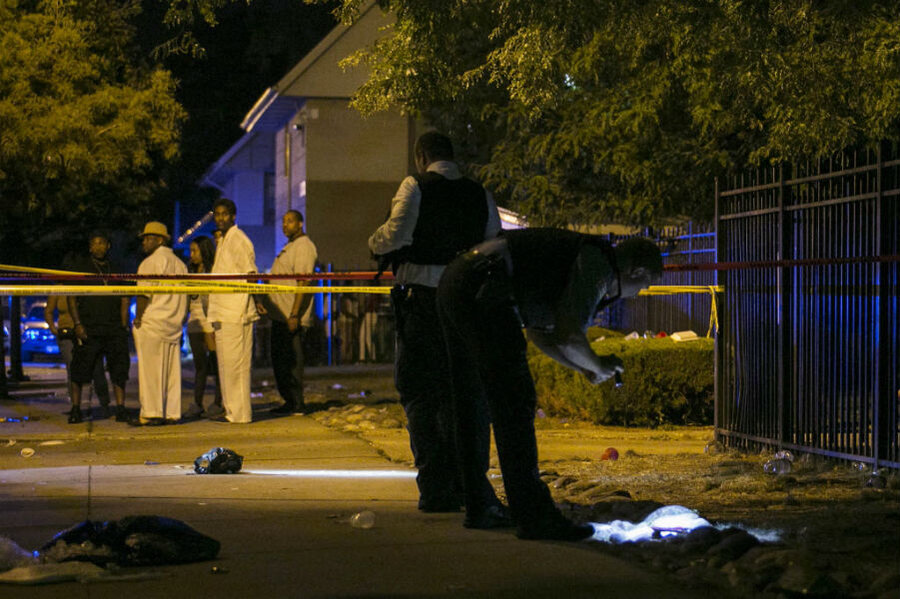National crime rates rise, but only in three cities
Loading...
The national murder rate is likely to increase by more than 13 percent by the end of this year, but this initially staggering statistic isn't reason for Americans to panic, a new report says.
The study, published Monday by researchers at the Brennan Center for Justice, predicts that the national homicide rate could make a 31.5 percent leap from 2014’s numbers and a 13.1 percent increase from last year by the end of 2016. Still the number of murders across the country hovers close to the historic low, and the rise comes almost entirely from an increase in murders in Chicago, along with high numbers of homicides in Baltimore and Washington, D.C.
The spike, while daunting at first glance, isn’t indicative of a larger trend, and most in the nation don't need to factor it in while gauging their own safety, researchers at the center, which is housed by the New York University School of Law, assured. In reality, the majority of America is far safer than it was in decades past.
"There is not a nationwide crime wave, or rising violence across American cities," the study's authors conclude. "Warnings of a coming crime wave may be provocative, but they are not supported by the evidence."
But without qualification, the surface findings of the report are the exact kind that some may choose to cite when deeming the nation's crime rate "out of control," as Republican presidential nominee Donald Trump has done. Declaring himself the "law and order" candidate, the businessman has won the support of law enforcement, securing an endorsement from the largest police union in the country over the weekend and vowing to clean up the streets he says are riddled with violent activity.
And for citizens across the nation, even those living outside of cities like Chicago that have been isolated as areas for concern, the study's results can have a staggering effect.
"The vast majority of normal citizens have no idea about crime trends," Matthew Robinson, a professor of government and justice at Appalachian State University in Boone, N.C., tells The Christian Science Monitor. While cities across the nation are much safer on average than they were five, 10, or 20 years ago, few people outside of areas where crime rates have shifted significantly see and understand the progress that's been made in terms of public safety.
"Historically, if you look at studies, people generally think crime is going up, but don't believe it's going up in their own neighborhoods," he added.
Such perceptions can stem from statements like those Mr. Trump has made, and from violent images and stories covered by the media. Additionally, increases in high-profile mass shootings and terrorism have stoked anxiety in citizens across the country, leading many to have emotional and, naturally, skewed responses that focus on individual incidents that sometimes seem more compelling than hard data.
The study examined rates of crime, violent crime, and homicide in the nation's largest cities. Comparing the numbers of those back to 1990, all have dropped significantly, with the homicide rate, in particular, falling from 30 murders for every 100,000 people to less than 10 last year. Overall, crime is only expected to see a 1.3 percent increase by the end of the year.
While some cities experienced more violence this year, others have become safer, and researchers would expect to see stagnation in the crime rate. But the spike in homicides this year comes primarily from Chicago, which researchers predict will see 234 of the 496 new murders accounting for the increase.
And it's this provocative statistic that the average American is more likely to recall. News consumers often watch and read stories of individual violent crimes or receive statistics out of context, leading them to remember dramatic, short-lived increases rather than consistent trends.
"You have to offer context," Jaclyn Schildkraut, an assistant professor in the justice department at the State University of New York at Osewgo, tells the Monitor. "Nobody ever says if you walk past 100,000 people on the street, here's how many people are going to get murdered on average. That comes down to reporting crime rates, not crime count."
In Chicago, where homicides are expected jump 9.1 percent, a shrinking police force and increased gang violence in some of the city's poor, highly segregated neighborhoods could be responsible for the shift, according to the report.
"We really don't know why crimes are increasing in some cities more than in others," Dr. Robinson, author of the 2014 book, "Media Coverage of Crime and Criminal Justice," says. "It's definitely not a national trend."
Uncovering the reasons for spikes, and finding subsequent ways to solve them, requires a more in-depth look at a community to pinpoint possible causes.
"You can't look at one moment in time," Dr. Schildkraut, who authored the 2016 book, "Mass Shootings: Media, Myths, and Realities," says. "Being able to look at [crime] over time is very important because it'll give you a picture of what's going on in a community."
Without examining the specific conditions that may have affected the numbers, advocating for officials to crack down on crime isn't a solid solution.
"If you're going to argue that we have to get tough, and that getting tough on crime works, then that assumes we're not tough now," Robinson says of Trump's crime rhetoric.
With the highest rates of incarceration of any industrialized nation and stricter sentencing than most other countries, Robinson says Trump call for a more diligent law enforcement service and harsher courts to stop crime loses its validity. Instead, it's important to examine the economic or political reasons behind such spikes to better understand and address issues like those in Chicago.
"The idea that if we suddenly just get tough, everything will get better, flies in the face of what we've been doing," he says.








